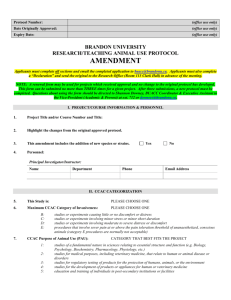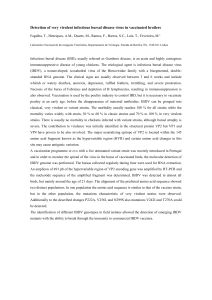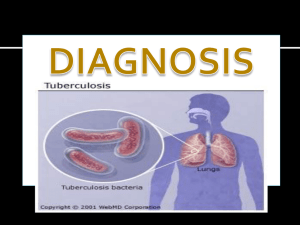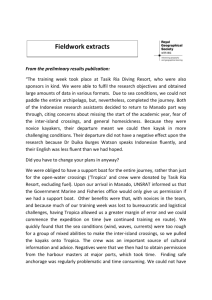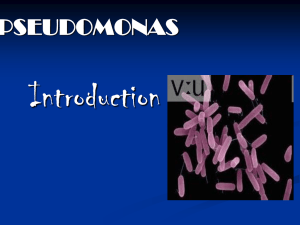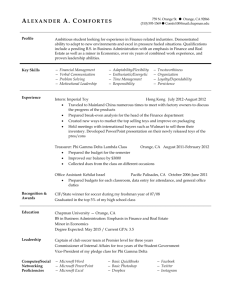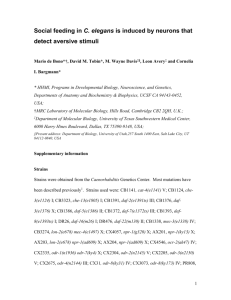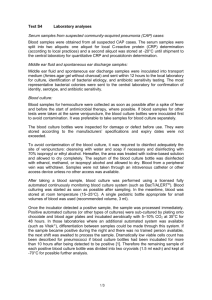- Northumbria Research Link
advertisement
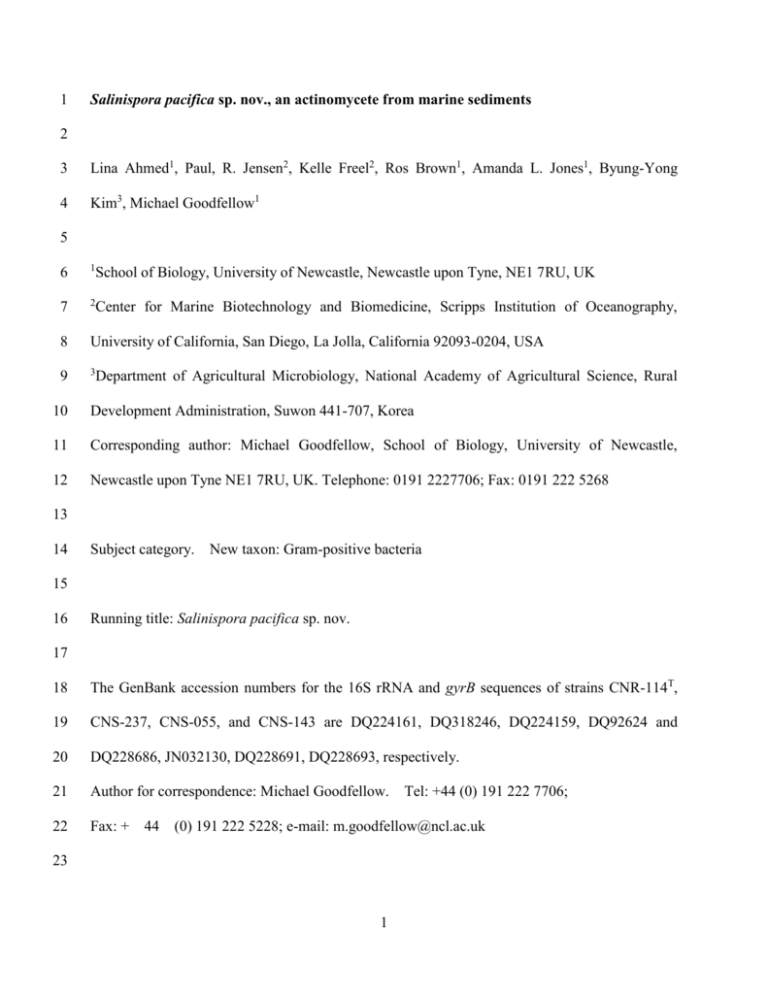
1 Salinispora pacifica sp. nov., an actinomycete from marine sediments 2 3 Lina Ahmed1, Paul, R. Jensen2, Kelle Freel2, Ros Brown1, Amanda L. Jones1, Byung-Yong 4 Kim3, Michael Goodfellow1 5 6 1 School of Biology, University of Newcastle, Newcastle upon Tyne, NE1 7RU, UK 7 2 Center for Marine Biotechnology and Biomedicine, Scripps Institution of Oceanography, 8 University of California, San Diego, La Jolla, California 92093-0204, USA 9 3 Department of Agricultural Microbiology, National Academy of Agricultural Science, Rural 10 Development Administration, Suwon 441-707, Korea 11 Corresponding author: Michael Goodfellow, School of Biology, University of Newcastle, 12 Newcastle upon Tyne NE1 7RU, UK. Telephone: 0191 2227706; Fax: 0191 222 5268 13 14 Subject category. New taxon: Gram-positive bacteria 15 16 Running title: Salinispora pacifica sp. nov. 17 18 The GenBank accession numbers for the 16S rRNA and gyrB sequences of strains CNR-114T, 19 CNS-237, CNS-055, and CNS-143 are DQ224161, DQ318246, DQ224159, DQ92624 and 20 DQ228686, JN032130, DQ228691, DQ228693, respectively. 21 Author for correspondence: Michael Goodfellow. 22 Fax: + 44 (0) 191 222 5228; e-mail: m.goodfellow@ncl.ac.uk 23 1 Tel: +44 (0) 191 222 7706; 24 Abstract 25 A polyphasic analysis was carried out to clarify the taxonomic status of four marine 26 actinomycete strains that share a phylogenetic relationship and phenotypic characteristics with 27 the genus Salinispora. These strains formed a distinct lineage within the Salinispora 16S rRNA 28 and gyrB trees and possessed a range of phenotypic properties and DNA:DNA hybridization 29 values that distinguished them from the type strains of the two validly published species in this 30 genus: Salinispora tropica (CNB-440T, ATCC BAA-916T) and Salinispora arenicola (CNH- 31 643T, ATCC BAA-917T). 32 conclusion. 33 type strain of which is CNR-114T (ATCC XXXXT = DSMZ YYYYT = KACC 17160T). The combined genotypic and phenotypic data support this It is proposed that the strains be designated as Salinispora pacifica sp. nov.; the 34 35 Keywords: Salinispora pacifica sp. nov.; polyphasic taxonomy; obligate marine actinomycete; 36 marine sediments; Fiji 37 38 Introduction 39 The genus Salinispora is among a small but growing number of actinomycete genera that have 40 been reported from marine sources (Han et al. 2003, Yi et al. 2004, Maldonado et al. 2005, Tian 41 et al. 2009). Unlike other marine-derived genera described to date, members fail to grow when 42 seawater is replaced with deionized water in the growth medium. The genus is currently 43 composed of two species, Salinispora arenicola and Salinispora tropica, which can be 44 distinguished from one another using a combination of chemical, genetic, and phenotypic 45 properties (Maldonado et al. 2005). Salinispora strains have a cosmopolitan distribution in 46 tropical and subtropical marine sediments (Jensen and Mafnas 2006; Freel et al. 2012) and have 2 47 also been reported from a marine sponge (Kim et al. 2005). Although their occurrence in more 48 temperate habitats has been observed when culture-independent methods are applied 49 (unpublished data), they have yet to be cultured from these environments. 50 51 The genus Salinispora is a rich source of secondary metabolites (Fenical and Jensen 2006) 52 including salinosporamide A, which is currently in clinical trials for the treatment of cancer 53 (Fenical et al. 2009). The two validly published species devote a large percentage of their 54 genomes to the biosynthesis of secondary metabolites (Penn et al. 2009), which are produced in 55 species-specific patterns (Jensen et al. 2007). In addition to these two species, a new 16S rRNA 56 phylotype, for which the name "S. pacifica" was proposed, was cultured from marine sediments 57 collected off Guam (Jensen and Mafnas 2006). Subsequently, additional strains belonging to this 58 lineage were cultured from marine sediments collected around the islands of Palau (Gontang et 59 al. 2007) and Fiji (Freel et al. 2012). This candidate species has greater phylogenetic diversity 60 than the two validly published species and forms a sister lineage to S. tropica (Jensen et al. 61 2007). The proposed type strain produces the secondary metabolite cyanosporoside A (Oh et al. 62 2006), which to date has not been observed from the other two Salinispora spp. The present 63 study employed a polyphasic approach to establish the taxonomic status of representative isolates 64 within this new Salinispora phylotype. The resultant data show that the strains form a novel 65 taxon, for which the name Salinispora pacifica sp. nov. is proposed. 66 67 Materials and methods 68 The strains used in this study were cultured from marine sediment samples collected from the 69 islands of Guam in 2002 (CNR-114T) and Palau in 2004 (CNS-055, CNS-143, CNS-237) as 3 70 previously described in Jensen et al. (2005) and Gontang et al. (2007), respectively. The strains 71 were isolated using a heat shock method of 55°C for six minutes followed by dilution plating 72 onto seawater agar (Gontang et al. 2007). The strains were maintained on A1 agar (1.0% starch, 73 0.4% yeast extract, 0.2% peptone, 1 liter seawater) and stored frozen at -80°C in A1 74 supplemented with 10% glycerol. Biomass for DNA:DNA relatedness and gene sequencing was 75 prepared by growing the strains in A1 broth with shaking at 230 rpm for 10-14 days at 27°C 76 prior to harvesting by centrifugation. Genomic DNA extraction, PCR amplification, and the 77 sequencing of 16S rRNA and gyrB genes were carried out as previously described (Jensen and 78 Mafnas 2006). Sequences were checked for accurate base calling using Sequencher (version 4.5, 79 Gene Codes Corp., Ann Arbor, MI), aligned using Clustal X (Thompson et al. 1997), and 80 imported into MacClade (version 4.07, Sinauer Associates, Sunderland, MA) for manual 81 alignment. Sequence similarities were calculated using various NCBI (National Center for 82 Biotechnology Information) and BLAST (Basic Alignment Search Tool) functions. Neighbor- 83 joining, maximum-parsimony, and bootstrap analyses were performed using PAUP (version 84 4.0b10, Sinauer Assoc., Sunderland, MA). Sequence data have been deposited in the GenBank 85 database (http://www.ncbi.nlm.nih.gov/Genbank/index.html) for strains CNR-114T, CNS-237, 86 CNS-055, and CNS-143 under the accession numbers DQ224161, DQ318246, DQ224159, and 87 DQ92624 for 16S rRNA genes and DQ228686, JN032130, DQ22869, and DQ228693 for gyrB 88 genes, respectively. DNA:DNA relatedness studies were carried out between strain CNR-114T, 89 S. arenicola CNH-643T and S. tropica CNB-440T, respectively using the identification service at 90 the Deutsche Sammlung von Mikroorganismen und Zellkulturen (Braunschweig, Germany) as 91 described by Kim et al. (1999). 92 4 93 Cultural, morphological and staining properties 94 The strains were examined for cultural and morphological features following growth for 3 weeks 95 at 28oC on glycerol-asparagine agar (ISP [International Streptomyces Project] medium 5), 96 oatmeal agar (ISP medium 3), inorganic salts-starch agar (ISP medium 4), peptone-yeast extract 97 agar (ISP medium 1) and yeast extract-malt extract agar (ISP medium 2) (Shirling and 98 Gottlieb, 1966) prepared using 75% seawater. The spore arrangement and spore surface 99 ornamentation of isolate CNR-114T were observed by examining gold coated, dehydrated 100 specimens prepared from an ISP medium 2 agar plate using a scanning electron microscope 101 (Cambridge Stereoscan 240) and the procedure described by O’Donnell et al. (1993). Gram 102 reaction and Ziehl-Neelsen preparations were examined by light microscopy following growth 103 on ISP 2 medium agar as in an earlier study (Maldonado et al. 2005). 104 105 Phenotypic properties 106 The strains were examined for their ability to hydrolyse aesculin, allantoin and urea, to reduce 107 nitrate, to degrade adenine, DNA, elastin, guanine, hypoxanthine, starch, Tween 60, uric acid, 108 xanthine and xylan, and for their capacity to use sole nitrogen sources using the media and 109 methods described by Williams et al. (1983). They were tested for the ability to use a range of 110 sole carbon compounds using the basal medium of Stevenson (1967), for tolerance to 111 temperature, pH and sodium chloride using ISP medium 4 agar and for their sensitivity to 112 antibiotics using glucose-yeast extract agar (Gordon and Mihm 1962) as the basal medium. All 113 media were prepared using 75% seawater and tests examined weekly for up to four weeks, as 114 appropriate; all of the tests were incubated at 28oC, apart from the temperature tests. 115 Constituent enzyme activities of the strains were determined using API ZYM strips 5 116 (BioMerieux) according to the manufacturer’s instructions; a standard inoculum equivalent to 2.5 117 on the McFarland scale (according to manufacturers guidelines; Pro-Lab Diagnostics) was used 118 to inoculate the strips. Assimilation of a broad range of substrates was determined using Biolog 119 GP2 plates. To this end, biomass of each of the strains obtained by centrifugation of modified 120 Bennett’s broths (Jones 1949) prepared using 75% seawater was suspended in Biolog inoculating 121 fluid to give a standard suspension equivalent to McFarland scale 5. Aliquots of the resultant 122 suspension (150 µl) were pipetted into the wells of the microplates which were incubated at 28oC 123 for up to 7 days when the plates were read visually to detect the colour changes which indicated 124 positive results. 125 126 Chemotaxonomy 127 Biomass for all but one of the chemotaxonomic procedures was harvested, by centrifugation, 128 from strains grown for 5 days at 28oC in shake flasks of M1 broth, washed twice in distilled 129 water and freeze-dried. Strains CNS-237, CNR-114T and DSM 44818T were examined using 130 standard methods to determine the diagnostic isomers of diaminopimelic acid (A2pm; Staneck 131 and Roberts 1974), isoprenoid quinones (Collins, 1994), muramic acid type (Uchida et al. 1999), 132 mycolic acids (Minnikin et al. 1975), polar lipids (Minnikin et al., 1984) and whole-organism 133 sugars (Hasegawa et al. 1983). Biomass for the fatty acid analyses on all of the strains was 134 harvested from shake flasks of Trypticase Soy broth (Difco), prepared with 75% seawater, and 135 incubated at 28oC for 14 days. Fatty acids extracted from the resultant preparation were 136 methylated and analysed by gas liquid chromatography using the standard Sherlock Microbial 137 Identification (MIDI) system and the ACTINO 5 database (Sasser 1990). 138 6 139 140 Results and discussion 141 The two validly published species within the genus Salinispora have distinct biogeographical 142 distributions in marine sediments with S. arenicola being recovered from global collection sites 143 while S. tropica, to date, has only been recovered from Caribbean locations (Jensen and Mafnas 144 2006; Freel et al., 2012). The present investigation involves strains CNR-114T, CNS-055, CNS- 145 143, and CNS-237, which were recovered from marine sediments collected from tropical Pacific 146 Ocean locations off the islands of Palau and Guam. These strains form a distinct phylogenetic 147 lineage that is sister to S tropica. Based on DNA:DNA hybridization values, they were proposed 148 to represent a new species (Jensen and Mafnas 2006). Strains within this lineage have been 149 recovered from sites throughout the Pacific Ocean and from the Red Sea and display 150 considerable phylogenetic diversity relative to the two validly published species (Freel et al. 151 2012). These strains originate from collection sites that also yielded S. arenicola but not S. 152 tropica providing further evidence for geographical isolation between S. tropica and the strains 153 described in this paper. 154 155 Phylogenetic analyses 156 The 16S rRNA gene sequences for strains CNR-114T, CNS-055, CNS-143, and CNS-237 were 157 aligned to those for Escherichia coli (accession number J01695) and the type strains for S. 158 tropica (CNB-440T, ATCC BAA-916T) and S. arenicola (CNH-643T, ATTC BAA-917T). 159 Included in this alignment are the two S. arenicola sequence variants recovered from the Sea of 160 Cortez (Jensen and Mafnas 2006), represented by CNH-962 (DQ224162) and CNP-152 161 (DQ224164). This alignment, with common gaps removed, revealed that strains CNR-114T and 7 162 CNS-143 are clonal at the 16S rRNA gene level, while strains CNS-055 and CNS-237 represent 163 sequence variants that have been designated as phylotypes “A” and “B”, respectively. Of the 164 total 1479 nucleotide positions examined, the three sequence types have four polymorphic 165 positions. When considering all 16S rRNA gene sequence types observed to date for this lineage 166 at least 13 variable nucleotide positions have been documented (Freel et al. 2012), which is 167 considerably greater than that observed for S. tropica (no polymorphic sites) or S. arenicola 168 (seven polymorphic sites). There are three clade-specific signature nucleotides associated with 169 the four new strains. These consist of C, A, and A at positions 221, 234, and 264 in the 170 alignment, while in both S. tropica and S. arenicola the respective nucleotides are T, G, and G 171 (Freel et al. 2012). 172 rRNA gene sequence identity) with the S. arenicola type strain and all but 6 nucleotides (99.6% 173 16S sequence identity) with the S. tropica type strain, while the S. arenicola and S. tropica type 174 strains share 99.5% sequence identity. Strain CNR-114T shares all but 11 of 1479 nucleotide positions (99.3% 16S 175 176 A phylogenetic tree based on 16S rRNA gene sequences clearly places strains CNR-114T, CNS- 177 055, CNS-143, and CNS-237 within the genus Salinispora (Fig. 1). Interestingly, the recently 178 described genera Actinoaurantispora (Thawai et al. 2010) and Plantactinospora (Qin et al. 179 2009), neither of which were derived from marine sources, form a sister lineage with the genus 180 Salinispora (Fig. 1) replacing Micromonospora as the most closely related taxon and filling in 181 the taxonomic space between these genera. The clade formed by the four new strains clade was 182 separated 183 studies. For this reason, a second analysis using the gyrB housekeeping gene was performed. 184 This locus is known to provide good resolution within members of the family from S. tropica, the weak bootstrap support at this branch point warranted additional 8 185 Micromonosporaceae (Kasai et al. 2000). The gyrB gene tree (Fig. 2) shows strong support for 186 the phylogenetic separation of S. tropica (CNB-440) and the four new sequences using multiple 187 treeing methods and thus supports the sister relationship of these two lineages to S. arenicola. 188 189 DNA:DNA hybridization experiments were carried out between the strain CNR-114T and the 190 type strains of S. tropica CNB440T and S. arenicola CNH-643T. The mean hybridization values 191 calculated from two replicate experiments for CNR-114T with the type strains of S. tropica and 192 S. arenicola were 38.6% and 53.3%, respectively. All of these values are below the 70% cut-off 193 point recommended for the assignment of bacterial strains to the same genomic species (Wayne 194 et al. 1987). 195 196 Chemotaxonomic, cultural and morphological properties 197 The isolates exhibited cultural and morphological properties typical of members of the genus 198 Salinispora (Maldonado et al. 2005; Jensen et al. 2012). All of the isolates formed extensively 199 branched substrate hyphae, lacked aerial hyphae and failed to grow when seawater was replaced 200 with deionized water in a complex growth medium. They grew well on most of the ISP media 201 (Table 1) forming light to dark orange colonies, which on further incubation became dark due to 202 the formation of spores. Isolate CNR 114T formed round, smooth surfaced spores (0.6 x 1.0 m 203 diameter) singly and in clusters on ISP 2 agar (Fig. 3). 204 205 The strains contained meso-A2pm, arabinose, galactose and xylose as major whole-organism 206 hydrolysates, N-glycolated muramic acid, tetrahydrogenated menaquinones with nine isoprene 207 units as the predominant isoprenologue, complex mixtures of saturated, iso- and anteiso- fatty 9 208 acids 209 phosphatidylethanolamine, 210 phosphastidylinositol and phosphatidylinositol mannosides as major polar lipids (Fig. 4), but 211 lacked mycolic acids. This chemotaxonomic profile is consistent with the classification of the 212 strains in the genus Salinispora (Maldonado et al. 2005; Jensen et al. 2012). In general, all of the 213 strains showed similar fatty acid profiles though all but one of the isolates gave markedly lower 214 proportions of the major component and higher proportions of iso-C16:0 and C17:18c. with iso-C16:0 as the major component (Table phosphatidylmethylethanolamine, 2), diphosphatidylglycerol, phosphatidylglycerol, 215 216 Phenotypic tests 217 It can be seen from Table 3 that the isolates are distinguished from the type strains of S. 218 arenicola and S. tropica by a number of phenotypic properties, notably by their inability to 219 assimilate diverse compounds as sole carbon sources for growth. In contrast, all of the strains 220 had many phenotypic features in common. They all produced acid and alkaline phosphatase, 221 leucine arylamidase and naphthol-AS-BI-phosphohydrolase (API ZYM tests); hydrolysed 222 allantoin, reduced nitrate; degraded DNA, starch and Tween 60; used L-alanine, L-arginine, L- 223 methionine and L-valine as sole nitrogen sources, and were sensitive (g/ml) to chloramphenicol 224 (4), novobiocin (5) and oxytetracycline (8). None of the organisms produced cystine 225 arylamidase, -fucosidase, - or - galactosidase, - glucosidase, - glucuronidase, lipase 226 (C14), trypsin or valine arylamidase (AP1 ZYM tests); hydrolysed aesculin or urea; degraded 227 adenine, elastin, guanine, hypoxanthine, uric acid, xanthine or xylan; grew on D-arabinose, D- 228 arabitol, dextrin, dulcitol, mannitol, ribose, L-sorbose, turanose or xylose as sole carbon sources 229 (all at 1%, w/v); used L-aspartic acid as a sole nitrogen source or were sensitive (g/ml) to 230 ampicillin (8), gentamicin (5), novobiocin (25), cephaloridine (4) and streptomycin (25 g). 10 231 The isolates showed different responses to several tests, notably the ability to produce esterase 232 (C4), esterase lipase (C8), -glucosidase, N-acetyl--glucosamidase and -mannosidase (API 233 ZYM tests) and to use L-histidine as the sole nitrogen source. 234 235 Conclusions 236 The strains analyzed here form a distinct and well-supported phylogenetic lineage within the 237 genus Salinispora. There is currently no evidence that these strains overlap in their geographic 238 distribution with the sister lineage S. tropica suggesting that geographic isolation (allopatry) may 239 have played a role in the diversification event. It is evident from the genotypic and phenotypic 240 data that the isolates can be distinguished readily from the type strains of S. arenicola and S. 241 tropica. It is, therefore, proposed that the isolates be recognized as a new species of the genus 242 Salinispora, Salinispora pacifica with isolate CNR 114T as the type strain. 243 244 Description of Salinispora pacifica sp. nov. 245 Salinispora pacifica (pa.cif.ica L. fem. adj. pacifica of the pacific). 246 247 The description is based on data from this and an earlier study (Oh et al. 2006). 248 249 Aerobic, Gram-positive, non-acid-fast actinomycetes, which form a substrate mycelium that 250 carries round, smooth-surfaced spores singly and in clusters. Strains fail to grow when seawater 251 is replaced with deionized water in complex growth media. Good growth occurs on ISP media 252 prepared using 75% seawater. Grows between 20 and 30oC, optimally around 28oC and from 11 253 pH7.0 to 9.0. Additional phenotypic properties are cited in the text and in Table 2. The 254 chemotaxonomic properties are typical of the genus. The type strain produces cyanosporoside A. 255 256 The type strain, CNR-114T (= ATCC# = DSMZ# = KACC 17160T), was isolated from a marine 257 sediment sample collected at a depth of 82 m from the Pacific Ocean off the island of Guam on 258 19 January 2002. 259 260 Acknowledgements 261 The authors thank E. Gontang for the isolation of strains from Palau and assistance with 262 fieldwork in Guam. This research is a result of financial support from the National Institutes of 263 Health under grant U01-TW007401-01 from the Fogerty Center’s International Cooperative 264 Biodiversity Groups program. We thank the people of Fiji for their hospitality and for permission 265 to collect in the reefs of Kadavu Province and W. Aalbersberg (University of the South Pacific) 266 for providing laboratory space and facilitating field collections. We also thank the government of 267 Fiji for permission to work in their territorial waters. 268 269 References 270 271 Collins MD (1994) Isoprenoid quinones. In Goodfellow M, O’Donnell AG (eds) Chemical 272 methods in prokaryotic systematics. John Wiley & Sons, Chichester, pp 265-309 273 274 Felsenstein J (1981) Evolutionary trees from DNA sequences: a maximum likelihood approach. 275 J Mol Evol 17:368-376 12 276 277 Fenical W, Jensen PR (2006) Developing a new resource for drug discovery: marine 278 actinomycete bacteria. Nat Chem Biol 2: 666-673 279 280 Fenical W, Jensen PR, Palladino MA, Lam KS, Lloyd GK, Potts BC (2009) Discovery and 281 development of the anticancer agent salinosporamide A (NPI-0052). Bioorg Med Chem 17: 282 2175-2180 283 284 Freel CK, Edlund A, Jensen PP (2012) Microdiversity and evidence for high dispersal rates in 285 the marine actinomycete genus Salinispora. Environ Microbiol 14: 480-493 286 287 Gontang EA, Fenical W, Jensen PR (2007) Phylogenetic diversity of Gram-positive bacteria 288 cultured from marine sediments. Appl Environ Microbiol 73: 3272-3282 289 290 Gordon RE, Mihn JM (1962) Identification of Nocardia caviae (Erikson) nov. comb. Ann N.Y. 291 Acad. Sci 9: 628-636 292 293 Han SK, Nedashkovskaya OI, Mikhailov VV, Kim S.B, Bae KS (2003) Salinibacterium 294 amurskyense gen. nov., sp. nov., a novel genus of the family Microbacteriaceae from the marine 295 environment. Int J Syst Evol Microbiol 53: 2061-2066 296 297 Hasegawa T, Takizawa M, Tanida S.(1983) A rapid analysis for chemical grouping of aerobic 298 actinomycetes. J Gen Appl Microbiol 29: 319-322 13 299 Jensen PR, Mafnas C (2006) Biogeography of the marine actinomycete Salinispora. Environ 300 Microbiol 8: 1881-1888 301 302 Jensen PR, Gontang E, Mafnas C, Mincer TJ, Fenical W (2005) Culturable marine actinomycete 303 diversity from tropical Pacific Ocean sediments. Environ. Microbiol 7: 1039-1048 304 305 Jensen PR, Williams PG, Oh D-C, Zeigler L, Fenical W (2007) Species-specific secondary 306 metabolite production in marine actinomycetes of the genus Salinispora. Appl Environ Microbiol 307 73: 1146-1152 308 309 Jensen PR, Maldonado LA, Goodfellow M (2012) Genus Salinispora. In Goodfellow M, 310 Kämpfer P, Busse HJ, Trujillo ME, Suzuki J-i, Ludwig W, Whitman WB (eds) Bergey’s manual 311 of systematic bacteriology, 2nd edition, volume 5, part B. New York, pp 1118-1122 312 313 Jones KL (1949) Fresh isolates of actinomycetes in which the presence of sporogenous aerial 314 mycelia is a fluctuating characteristic. J Bacteriol 57: 141-145 315 316 Kasai H, Tamura T, Harayama S (2000) Intrageneric relationships among Micromonospora 317 species deduced from gyrB-based phylogeny and DNA relatedness. Int J Syst Evol Microbiol 50: 318 127–134 319 320 Kim SB, Brown R, Oldfield C, Gilbert, SC, Goodfellow M (1999). Gordonia desulfuricans sp. 321 nov., a benzothiophene-desulphurizing actinomycete. Int J Syst Bacteriol 49:1845-1851 14 322 323 Kim TK, Garson MJ, Fuerst JA (2005) Marine actinomycetes related to the "Salinispora" group 324 from the Great Barrier Reef sponge Pseudoceratina clavata. Environ Microbiol 7: 509-519 325 326 Kluge AG, Farris FS (1969) Quantitative phyletics and the evolution of anurans. Syst Zool 18: 1- 327 32 328 329 Maldonado L, Fenical W, Goodfellow M, Jensen PR, Kauffman CK, Ward AC (2005) 330 Salinispora gen nov., sp. nov., Salinispora arenicola sp. nov., and S. tropica sp. nov., obligate 331 marine actinomycetes belonging to the family Micromonosporaceae. Int J Syst Evol Microbiol 332 55: 1759-1766 333 334 Minnikin DE, Alshamaory L, Goodfellow M (1975) Differentiation of Mycobacterium, Nocardia 335 and related taxa by thin-layer chromatographic analysis of whole cell methanolysates. J Gen 336 Microbiol 88: 200-204 337 338 Minnikin, D E, O'Donnell AG, Goodfellow M, Alderson G, Athalye M, Schaal A, Parlett JH 339 (1984) An integrated procedure for the extraction of bacterial isoprenoid quinones and polar 340 lipids. J Microbiol Methods 2: 233-241 341 O’Donnell AG, Falconer C, Goodfellow M, Ward AC, Williams E, O’Donnell AG (1993) 342 Biosystematics and diversity amongst novel carboxydotrophic actinomycetes. Antonie van 343 Leeuwenhoek 64: 325-340 15 344 Oh D-C, Williams PG, Kauffman CA, Jensen PR, Fenical W (2006) Cyanosporasides A and B, 345 cyano- and chloro-cyclopenta [a]indene glycosides from the deep-sea marine actinomycete 346 "Salinispora pacifica". Org Lett 8: 1021-1024 347 348 Penn K, Jenkins C, Nett M, Udwary DW, Gontang EA, McGlinchey RP, Foster , B, Lapidus A, 349 Podell S, Allen EA, Moore BS, Jensen PR (2009) Genomic islands link secondary metabolism to 350 functional adaptation in marine Actinobacteria. J Int Soc Microb Ecol 3: 1193-1203 351 352 Qin S, Li J, Zhang Y-Q, Zhu W-Y, Zhao G-Z, Xu L-H, Li W-J (2009) Plantactinospora 353 mayteni gen. nov., sp., nov., a new member of the family Micromonosporaceae. Int J Syst Evol 354 Microbiol 59: 2527-2533 355 356 Saitou N, Nei M (1987) The neighbor-joining method: a new method for reconstructing 357 phylogenetic trees. Mol Biol Evol 4: 406-425 358 359 Sasser M (1990) Identification of bacteria by gas chromatography of cellular fatty acids. MIDI 360 Technical Note 101, MIDI Inc. Newark 361 362 Shirling EB, Gottlieb D (1966) Methods for characterization of Streptomyces species. Int J Syst 363 Bacteriol 16: 313-340 364 365 Sneath PHA, Sokal RR (1973) Numerical Taxonomy. Freeman. San Francisco 366 16 367 Staneck J, Roberts GD (1974) Simplified approach to identification of aerobic actinomycetes by 368 thin-layer chromatography. Appl Microbiol 28: 226-231 369 370 Stevenson JL (1967) Utilization of aromatic hydrocarbons by Arthrobacter spp. Can J Microbiol 371 13: 205-211 372 373 Thawai C, Tanasupawat S, Kudo T (2009) Actinoaurtispora siamensis gen. nov., a new member 374 of the family Micromonosporaceae. Int J Syst Evol Microbiol 60: 1660-1666 375 376 Thompson JD, Gibson TJ, Plewniak F, Jeanmougin F, Higgins DG (1997) The CLUSTAL_X 377 windows interface: flexible strategies for multiple sequence alignment aided by quality analysis 378 tools. Nucleic Acids Res 24: 4876-4882 379 380 Tian X-P, Zhi XY, Qiu Y-Q, Zhang Y-Q, Tang S-K, Xu LH, Zhang S, Li W-J (2009) 381 Sciscionella marina gen. nov., sp. nov., a marine actinomycete isolated from a sediment in the 382 northern South China Sea. Int J Syst Evol Microbiol 59: 222-228 383 384 Uchida K, Kudo T, Suzuki KI, Nakase T (1999) A new rapid method of glycolate test by diethyl 385 ether extraction, which is applicable to a small amount of bacterial cells of less than one 386 milligram. J Gen Appl Microbiol 45: 49-56 387 17 388 Wayne LG, Brenner DJ, Colwell RR, 9 other authors (1987) International Committee on 389 Systematic Bacteriology. Report of the ad hoc committee on reconciliation of approaches to 390 bacterial systematics. Int J Syst Bacteriol 37: 463-464 391 392 Williams ST, Goodfellow M, Alderson G, Wellington EMH, Sneath PHA, Sackin MJ (1983) 393 Numerical classification of Streptomyces and related genera. J Gen Microbiol 129:1743-1813 394 395 Yi H, Schuman P, Sohn K, Chun J. (2004) Serinicoccus marinus gen. nov., sp. nov., a novel 396 actinomycete with L-ornithine and L-serine in the peptidoglycan. Int J Syst Evol Microbiol 54: 397 1585-1589 398 18 1 Table 1. Growth and cultural characteristics of the Salinispora strains after two weeks at 28oC Characteristics S. pacifica S. arenicola S. tropica CNS-055 CNR-114T CNS-143 CNS-237 DSM 44819T CNH-643T DSM 44418T CNB-440T + Light orange +++ Orange +++ Orange +++ Orange +++ Orange +++ Orange ++ Light orange +++ Dark orange +++ Dark orange +++ Light orange +++ Orange +++ Orange ++ Light orange ++ Orange +++ Dark orange + Orange ++ Light orange ++ Light orange + Light orange ++ Orange ++ Orange +++ Orange +++ Dark orange +++ Orange N/A + Orange N/A N/A +++ Orange N/A Glucose-yeast extract agar (ISP medium 2) Growth Substrate mycelium Glycerol-asparagine agar (ISP medium 5) Growth Substrate mycelium Inorganic salts-starch agar (ISP medium 4) Growth Substrate mycelium Oatmeal agar (ISP medium 3) Growth Substrate mycelium Peptone-yeast extractiron agar (ISP medium 6) Growth Substrate mycelium 19 Tryptone-yeast extract agar (ISP medium 1) Growth Substrate mycelium +++ Light orange +++ Orange +++ Orange +++ Orange +++ Dark orange +++ Orange +++ Orange +++ Orange ++ Orange ++ Orange +++ Orange +++ Orange Tyrosine agar (ISP medium 7) 1 2 3 4 Growth Substrate mycelium Key: +++, abundant growth; ++, moderate growth; +, poor growth; -, no growth 20 1 Table 2. Major and minor fatty acids of the Salinispora strains 2 Characteristics S. pacifica S. arenicola S.tropica CNS 055 CNR 114T CNS 143 CNS 237 DSM 44819T DSM 44418T iso- C14:0 2.9 3.7 1.7 1.2 1.6 1.3 iso- C15:0 anteiso- C15:0 C16:0 iso- C16:1 H iso-C16:0 C17:0 iso- C17:0 anteiso- C17:0 9.7 2.6 6.0 − 22.5 13.9 2.3 2.6 14.2 3.9 3.4 1.5 27.0 8.0 2.6 3.5 17.5 2.5 1.6 2.7 30.5 3.5 3.6 3.5 7.7 1.1 1.9 3.5 43.4 0.9 4.4 3.1 8.5 1.6 0.6 6.5 46.1 0.7 1.8 4.9 6.4 1.6 0.7 9.6 49.8 0.8 0.9 4.2 5.3 16.6 3.8 3.1 16.8 2.1 − 3.9 − 1.8 2.5 4.9 9.9 0.8 1.5 0.9 8.3 5.4 3.7 2.5 6.0 5.3 4.4 0.6 2.7 0.5 8.9 4.6 4.1 0.5 1.7 C17:0 10-methyl C17:1 ω8c C18:0 C18:0 10-methyl Summed Feature 6 Summed Feature 9 − − 7.3 − 8.8 3 *Peaks that accounted for less than 2% of the total fatty acid composition strains are not included in the Table. 4 5 6 7 † Summed feature represent two or three fatty acids that could not be separated using the MIDI system. Summed feature 6 consisted of C19:1 11c and / or C19:1 9c and summed feature 9 of co-methyl C16:0 and / or iso-C17:1 9c 21 1 2 3 Table 3. Phenotypic properties that separate the Salinispora isolates from the type strains of S. arenicola and S. tropica Characteristics Isolates S. arenicola DSM 44419T S. tropica DSM 44418T − − − + + + − − + − − + − + + + − − + − − Sole nitrogen sources: L-alanine L-glutamic acid − + + − − − Susceptibility to (g ml-1) Gentamicin (5) Penicillin (5) − − + + + + API ZYM test: -chemotrypsin Growth at 10°C Growth on sole carbon sources at 1%, w/v: Erythritol Fucose, melezitose Lactose Assimilation (Biolog GP 2) of: Arbutin Dextrin, D-fructose, gentibiose, glycerol, -ketoglutaric acid, D-mannitol, methyl pyruvate, pyruvic acid, Tween 80 4 5 6 Key: +, positive; -, negative. 22 1 2 Figure legends 3 Fig. 1. Neighbour-joining phylogenetic tree (Saitou and Nei 1987) created from 33 nearly 4 complete (1359 nucleotides) 16S rRNA gene sequences showing relationships between strains 5 CNS-143, 6 Micromonosporaceae. Asterisks indicate branches of the tree also found using the unweighted 7 pair group method with arithmetic means (Sneath and Sokal 1973), maximum-likelihood 8 (Felsenstein 1981), and maximum-parsimony (Kluge and Farris 1969) methods. Numbers at 9 nodes indicate the level of bootstrap support (%) based on a neighbour-joining analysis of 1000 10 CNR-114T, CNS-055, and CNS-237 and representatives of the family re-sampled datasets; only values above 55% are shown. 11 12 Fig. 2. Neighbour-joining phylogenetic tree (Saitou and Nei 1987) created from 18 gyrB 13 nucleotide sequences (714 nucleotides) showing relationships between strains CNS-143, CNR- 14 114T, CNS-055, and CNS-237 and representatives of some genera classified in the family 15 Micromonosporaceae. 16 pair-group method with arithmetic means (Sneath and Sokal 1973), maximum-likelihood 17 (Felsenstein 1981), and maximum-parsimony (Kluge and Farris 1969) methods. Numbers at 18 nodes indicate the level of bootstrap support (%) based on a neighbour-joining analysis of 1000 19 re-sampled datasets; only values above 55% are shown. Asterisks indicate branches of the tree also found using the unweighted 20 21 Fig. 3. Scanning electron micrograph of Salinispora pacifica CNR-114T growing on ISP medium 22 2 supplemented with 75% seawater after incubation at 28oC for three weeks. Bar, 2 m. 23 23 1 Fig. 4. Two-dimensional-chromatography of polar lipids of Salinispora pacifica CNR-114T 2 stained with molybdophosphoric acid spray (Sigma). Chloroform: methanol: water (32.5: 12.5 : 3 2.0 v/v) was used in the first direction and chloroform: acetic acid: methanol: water (40: 7.5: 6.2 4 v/v) in the second direction. DPG, diphosphatidylglycerol; PE, phosphatidylethanolamine; PG, 5 phosphatidylglycerol, PI, phosphatidylinositol, PME, phophatidylmethylethanolamine and PIDM, 6 phosphatidylinositol dimannosides. 7 8 9 24 1 Figure 1 25 1 2 3 4 5 6 7 8 9 10 11 12 13 14 15 16 17 18 19 20 21 22 23 24 25 26 27 28 Figure 2 100* 99* 98* 100* 100* 86 30 100* 100* 35 36 37 38 39 40 41 42 43 44 45 46 47 48 49 50 51 52 53 54 34 32 33 100* 26 29 31 1 2 Figure 3 3 4 5 6 27 1 2 Figure 4 3 4 5 28
